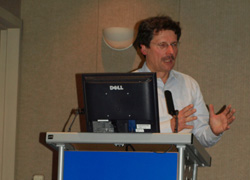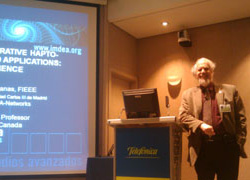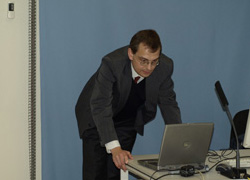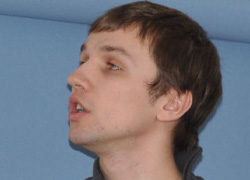IMDEA Networks

Archives: Events
Key Issues of Peer-to-Peer Mechanisms as Future Internet Communications
Ralf Steinmetz is one of the world experts in multimedia and P2P applications, is the author of one of the most referenced books in the area, and he has received the ACM Multimedia Award.
Since early 1996 Ralf Steinmetz has been a professor at the dept. of Electrical Engineering and Information Technology as well as at the dept. of Computer Science of the Darmstadt University of Technology, Germany. There he is in charge of a chair position as managing director of the "Multimedia Communications Lab". From late 1996 until late 2001 he directed the GMD/Fraunhofer Integrated Publications and Information Institute. In 1999 he founded the Hessian Telemedia Technology Competence Center (httc e.V.). On whose board he has since served as chair. He is also one of the directors of the Information Transfer Office at the university. From 2002 to 2004 as dean he managed the department.
Read more arrow_right_altDelay Tolerant Bulk Data Transfers on the Internet or how to book some terabytes on "red-eye" bandwidth
Many emerging scientific and industrial applications require transferring multiple terabytes of data on a daily basis. Examples include pushing scientific datasets from particle accelerators/colliders to laboratories around the world, synchronizing data centers in different continents, and replicating collections of high definition videos from Olympic Games, taking Location on a different time-zone. A convenient property of all above applications is their ability to tolerate delivery delays from a few hours to a few days. Such Delay-Tolerant Bulk (DTB) transfers are currently being serviced through the postal system using hard drives and DVDs, or through expensive dedicated networks.
Read more arrow_right_altDistributed and Collaborative Hapto-Virtual Environments and Applications: Effects of Networking Impairments on Quality of Experience
Multimedia Communications, involving traditional media such as audio, video, text, 2D graphics, have become parts of everyday e-life. New digitalmedia, such as Virtual Reality and Haptics, have now added new dimensions to multimedia tele-collaboration. This presentation will introduce basic issues on Distributed and Collaborative Virtual Environments, where the feeling of touch (haptics) and its transmission over networks is becoming essential. Various applications will be described ranging from industrial training to e-commerce to medical education. Effects of networking =93quality of experience on collaborative hapto-virtual applications will be discussed and methods for delay and jitter compensation will be described.
Read more arrow_right_altJTP: An Energy-conscious Transport Protocol for Ad Hoc Networks
JTP: An Energy-conscious Transport Protocol for Ad Hoc Networks Energy consciousness is percolating rapidly through all areas of research for technologies that are power driven. In the context of networking, the area of ad hoc networks has been the main driving factor pushing energy-related research, with significant efforts pursued mainly at the physical, data-link and routing layers of the protocol stack.
Read more arrow_right_altInnovating the Multi-Provider Internet
With the Internet offering a single best-effort service, there have been numerous proposals of diversified network services that align better with the divergent needs of different distributed applications. The failure of these innovative architectures to gain wide deployment is primarily due to economic and legacy issues, rather than technical shortcomings. We propose a new paradigm for network service differentiation where design principles account explicitly for the multiplicity of Internet service providers and users as well as their economic interests in environments with partly deployed new services. Our key idea is to base the service differentiation on performance itself, rather than price.
Read more arrow_right_altSeminar-IP Autoconfiguration for Vehicular Networks
More information about Marco Gramaglia The seminar will be conducted in English
Read more arrow_right_altWhat do opportunism, data mining and coordination have to do with system-level optimization of wireless networks?
We present a system-level framework to mitigate interference using coarse grained coordination of transmissions across base stations. Our approach is based on collecting and mining measured data capturing a user population's diversity in sensitivity to interference. The talk introduces the abstractions and optimization framework we have devised to enable this type of coordination. The talk is in two parts addressing what we deem to be key areas of inquiry.
Read more arrow_right_altOptimization, Pricing and Control in Networks
In the last decade, a new theoretical foundation for quantitative network research has emerged. Its key ingredients are the following: economic models to formulate network resource allocation as a convex optimization problem; use of optimization methods to devise decentralized solutions to these problems, in terms of dynamic adaptation of the relevant variables; tools of control theory to understand the dynamic properties of these methods. The resulting body of theory has been highly successful in providing models for TCP congestion control, describing how local protocols should be designed to allow for interesting global properties to emerge. From here, recent research has advanced this methodology to other layers of the protocol stack. In this course we will provide an introduction to this interdisciplinary field of research.
Read more arrow_right_altxIP - eXtending IPv4 address space
Instructor:
Lugar:
Fecha: 12th May, 2009, 10:00 – 11:00
Organización:
Read more arrow_right_alt
Load Balancing is Not Optimal in Wireless Systems With Dynamic Interference
We study the impact of policies to associate users with base stations/access points on flow-level performance in interference limited wireless networks.
Most research in this area has used static interference models (i.e., neighboring base stations are always active) and resorted to intuitive objectives such as load balancing. In this paper, we show that this can be counter productive, and that asymmetries in load can lead to significantly better performance in the presence of dynamic interference which couples the transmission rates experienced by users at various base stations. We propose a methodology that can be used to optimize the performance of a class of coupled systems, and apply it to study the user association problem. We show that by properly inducing load asymmetries, substantial performance gains can be achieved relative to a load balancing policy (e.g., 15 times reduction in mean delay). We present a novel measurement based, interference-aware association policy that infers the degree of interference induced coupling and adapts to it.












Recent Comments